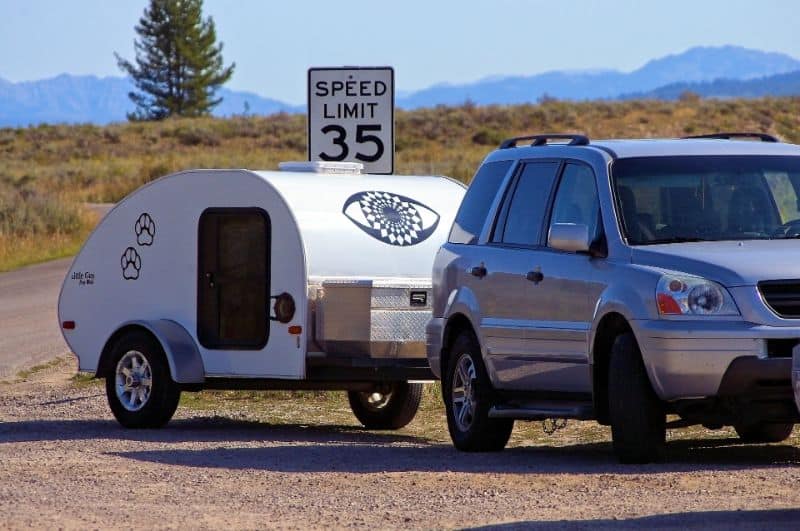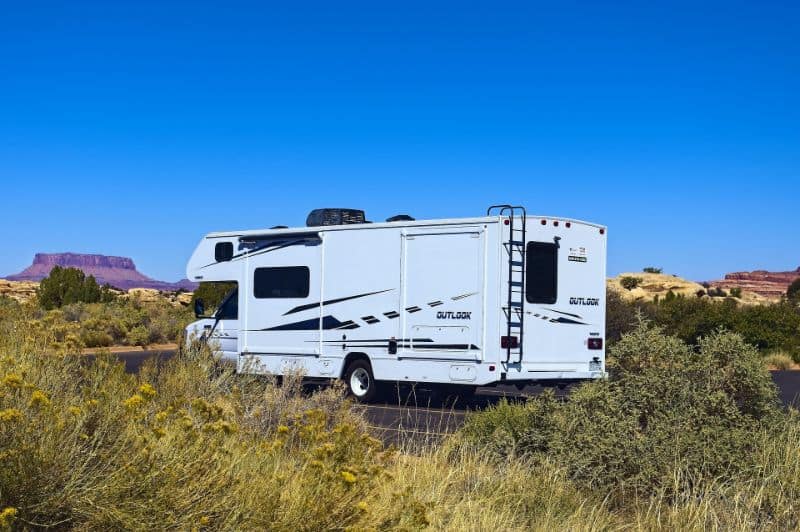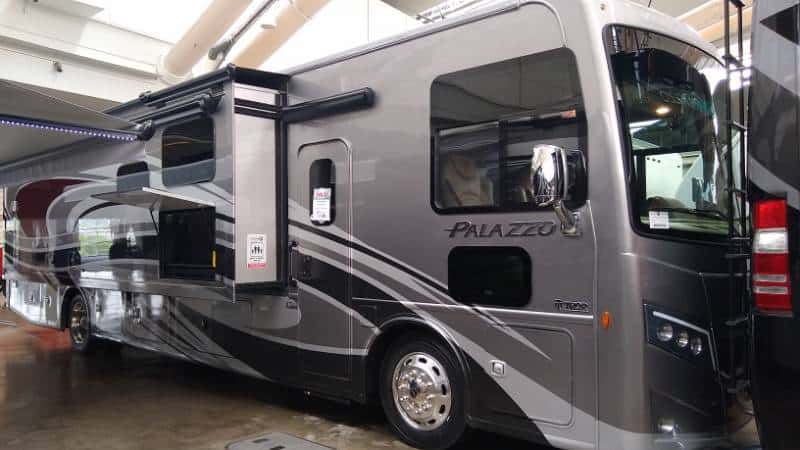Let’s talk about America’s most popular subject: width.
Vertically-challenged pop-ups, scrawny teardrops, fluffy Class C’s, willowy Class B’s, behemoth Class A’s, big-boned 5th wheels and dad-bod travel trailers. All of ’em.
There are no “bad” RV body types. But there’s also no such thing as a one-size-fits-all RV.
The width of your RV determines where you can go and what you can fit inside. It dictates:
- Your choice of tow vehicle
- Whether you need an oversize vehicle permit
- If your RV is handicap-accessible
- Whether you can can boondock
- Where you can park
And much more.
Many RV owners completely ignore the importance of width – until they realize their mistake! (Usually while stuck halfway through a hairpin turn). Length isn’t the only thing that matters! (Cue the jokes).

How Is RV Width Measured?
Fair warning: The width of an RV is NOT measured across its absolute widest point!
How to Measure the Body Width of a Standard RV
RVs are not considered Commercial Motor Vehicles (CMVs) under federal law and are exempt from most regulations under the Federal Highway Administration.
Instead, RV size regulation is generally left up to the state.
How is RV width measured? Generally, RV width is the distance from sidewall-to-sidewall or fender-to-fender, whichever is greater. This is defined as the “body width.”
Since most RVs sit over their wheels, the width of conventional motorhome or trailer is simply measured from sidewall-to-sidewall. Body width is what people are referring to when they talk about RV size.
“But what about the exterior lights, handles, speakers, windows, and that sort of thing?” you ask. Great question! Let’s keep going.
Do Lights, Awnings, and Exterior Components Affect RV Width?
The exterior features on your RV sidewalls such as doors, trim, windows, lights, ladders, awnings, handles, etc. are all called “appurtenances.”
In most states, appurtenances are allowed to extend 6” beyond the body on either side of the RV.
Certain states have more restrictive rules.
- Oregon, New York, Wisconsin and South Carolina allow 6” on the passenger side but only 4” on the driver’s side.
- Washington only allows 4” for appurtenances but 6” for awnings. Oklahoma allows 4” for appurtenances but 8” for awning.
- Missouri, Montana, and Minnesota do not allow appurtenances to extend beyond the mirrors of the motorhome or tow vehicle.
- Many states allow up to 6” per side but cap the total extra width at less than 12”. Colorado mandates a maximum width of 114”. Kansas restricts absolute maximum width to 108”.
- Some states have different width requirements for trailers versus motorhomes. Massachusetts, for instance, allows 108” motorhomes but only 102” wide trailers.
Because rules vary by state, research the RV and road regulations in your state.
Do RV Slide-Outs Affect Width?
The width of your RV with the slide-outs extended has no impact on its body width. It makes no difference to a Highway Patrol officer how many or how deep your slide-outs are.
However, you should know the width of your RV with slide-out[s] extended when choosing a campsite! You don’t want to extend a slide-out only to hear the sickening “crunch” when it collides into a tree!
For reference, 3-ft deep slide-outs are the most common slide-out depth. If you have opposing slide-outs on a wide-body 102” RV, then your total expanded width would be around 14’ 6”.
What Is the Maximum Width of an RV?
Alright, let’s get to some numbers!
In most states, the maximum body width of an RV is 102” on designated roads like Interstates and major highways.
The following states restrict maximum RV width to 96” for non-designated roads, like urban streets and backcountry roads. On designated roads, the allowable width is still 102”.
- West Virginia
- Tennessee
- New York
- Missouri
- Maryland
- Illinois
- Arizona
- Alabama
There are a few other outliers. Washington D.C. won’t allow anything bigger than 96”! But Hawaii allows a whopping 108” – that’s nine feet! – for all motor vehicles!
Here is a table of maximum allowable RVs widths by state, courtesy of RVIA.
RV Maximum Width by State
| State | Motorhomes | Towable |
|---|---|---|
| Alabama | 96/102 | 96/102 |
| Alaska | 102 | 102 |
| Arizona | 96/102 | 96/102 |
| Arkansas | 102 | 102 |
| California | 102 | 102 |
| Colorado | 102 | 102 |
| Connecticut | 102 | 102 |
| Delaware | 102 | 102 |
| Florida | 102 | 102 |
| Georgia | 102 | 102 |
| Hawaii | 108 | 108 |
| Idaho | 102 | 102 |
| Illinois | 96/102 | 96/102 |
| Indiana | 102 | 102 |
| Iowa | 102 | 102 |
| Kansas | 102 | 102 |
| Kentucky | 102 | 102 |
| Louisiana | 102 | 102 |
| Maine | 102 | 102 |
| Maryland | 96/102 | 96/102 |
| Massachusetts | 108 | 102 |
| Michigan | 102 | 102 |
| Minnesota | 102 | 102 |
| Mississippi | 102 | 102 |
| Missouri | 96/102 | 96/102 |
| Montana | 102 | 102 |
| Nebraska | 102 | 102 |
| Nevada | 102 | 102 |
| New Hampshire | 102 | 102 |
| New Jersey | 102 | 102 |
| New Mexico | 102 | 102 |
| New York | 96/102 | 96/102 |
| North Carolina | 102 | 102 |
| North Dakota | 102 | 102 |
| Ohio | 102 | 102 |
| Oklahoma | 102 | 102 |
| Oregon | 102 | 102 |
| Pennsylvania | 102 | 102 |
| Rhode Island | 102 | 102 |
| South Carolina | 102 | 102 |
| South Dakota | 102 | 102 |
| Tennessee | 96/102 | 96/102 |
| Texas | 102 | 102 |
| Utah | 102 | 102 |
| Vermont | 102 | 102 |
| Virginia | 102 | 102 |
| Washington | 102 | 102 |
| West Virginia | 96/102 | 96/102 |
| Wisconsin | 102 | 102 |
| Wyoming | 102 | 102 |
| Washington D.C. | 96 | 96 |
You can visit the original table for more information, such as additional rules on appurtenances and safety equipment.
Do I Need an Oversize Permit for My RV?
If you plan on towing or driving your RV down a road where you exceed the legal limit, then yes, you must obtain an oversize permit from the state.
In some cases, you will not be allowed to travel certain roads.
In others, traveling hours may be restricted (outside of popular commuting hours). You may be required to wear an “Oversize Load” banner, or a police escort may be required.
Remember – ignorance is no excuse for the law! You can be fined and your RV impounded for traveling a road over the legal width limit.
What Is the Average Width of an RV?
Now that you know all the rules about RV width … how wide are these big rigs, actually?
I’ll break down all the options for RV width in the next section. Here’s the Spark Notes version:
- Typical Class B vans are about 7’ wide.
- Typical Class C motorhomes are about 8’ wide.
- Typical Class A coaches are about 8.5’ wide.
- Towable RVs range from 80 to 102”, with 8’ (96”) being the most common.
Keep in mind that big interstate highway lanes are about 12’ wide, but urban streets can be 10’ or less!
Where Can I Park My RV?
A typical automobile parking spot is 9’ wide by 18’ long. These are too small for most RVs.
Dedicated RV parking spots in federal locations (National Parks, rest stops, etc.) must be 20” wide (or 16’ wide with adjoining parking space). These parking spots are wide enough for any RV.
Pint-Sized: RVs Under 80” Wide

RVs less than 80” in width aren’t exactly deserving of the term “RV.” These are the smallest of the small, usually without standing room, shower facilities, etc.
Examples include:
- Minivan conversions
- Teardrop trailers
- Expedition trailers
- Off-road slide-in truck campers
Where Can You Travel?
The benefit of a camper this small is you can go almost anywhere! “I go where I’m towed,” as the saying goes.
Minivan conversions are often used for weekend RV rentals simply because they’re no different than piloting a regular passenger vehicle. You can go anywhere you want – and your bed comes with you.
Slim and Svelte: RVs Between 80-86” Wide

Many Class B vans have a 7’ (84”) waistline.
You can also find compact travel trailers in this size, such as miniature travel trailers from NuCamp, Little Guy, InTech, etc. Another popular RV category is molded fiberglass campers, like a Casita or Scamp.
The big benefit of a compact travel trailer is that you don’t need a special tow vehicle. Sometimes, you don’t even need towing mirrors!
There’s a big trade-off, though. Most RVs this small are hardshells without slide-outs. They don’t get any bigger once parked and deployed.
Also, many designs at this size have beds running width-wise. Double-check if you need to climb over your partner in the morning.
Examples include:
- Mega teardrops (NuCamp, Little Guy, InTech)
- Molded fiberglass campers (Scamp, Armadillo, Casita)
- Miniature travel trailers
- Standard truck campers
Where Can You Travel?
These narrow-waisted RVs, trailers, and truck campers can still go just about anywhere. You can drive down any road you want. You can even park (almost) anywhere you want!
While a little bit bigger than a standard passenger vehicle, a 7’ wide RV is still slim enough to cruise urban streets and switchback backcountry paths. They are popular with the #vanlife movement for just that reason.
Average Joe: RVs Between 86-96” Wide

While you can find a few RVs 88, 90, or 92” wide, almost all RVs in this category are 96” wide (that’s 8 feet).
For many, many years, 96” has been considered the de facto standard RV width. It’s the most common width for travel trailers, 5th wheels, Class C’s, and many other RV types.
There’s a lot to love about an 8’ wide RV. I mean, the roominess! You can put a sofa along one wall, a kitchen along the other, and both people can enjoy their space at the same time.
However, 8 feet is quite a bit wider than the typical passenger car. You’ll need a big truck or SUV, with towing mirrors, to pull a rig this big.
If you’re piloting a motorhome, you may find driving an 8’ wide rig a white-knuckled experience. Spend some time in training (maybe take a driving course) before driving onto the open road!
You should also make sure your RV has sufficient cargo carrying capacity for your needs.
Where Can You Travel?
Because all states allow 96” wide RVs (except in very specific circumstances, like historic downtowns or 4WD mountain roads), you can *technically* go anywhere you want.
But it can be a challenge. You can’t park in most standard spots – and you definitely can’t parallel park in most areas!
You’ll find that driving is more tiring. You have to be alert at all times, especially when you’re making corner turns, driving 2-way roads, or traveling in bad weather.
Wide-Body: RVs Between 96-102” Wide

Wide-body RVs have rapidly become the new favorite design for luxury RVs. That extra 6” in width may not sound like much, but it’s amazing how much “more like home” an RV feels!
Most RVs in this category are 100 or 102”. Designers are trying to maximize every inch of space!
(For reference, a school bus is usually 100” wide, and a semi-truck trailer is about 102”).
Where Can You Travel?
You already know the pros and cons of a wide-body RV.
You get all the space you could want. Residential-style appliances fit perfectly. If you shout, you can hear an echo across the room. It’s wonderful.
… But … you’re basically driving a tank. For comparison, a Toyota Camry midsize sedan is almost exactly 6’ wide. You’re driving something 3’ wider than an average car! Add in the huge wheelbase, the heart-stopping height, and the thousands of thousand of pounds …
Some people don’t care about the extra width. They like the art of driving and enjoy the challenge.
Take a test drive first. More than a few RV owners have exchanged wide-body RVs for classic 8-ft’ers simply because they hated driving the thing.
P.S. Wide-body RVs typically have poor fuel economy, too. But there are a few things you can do to improve your mpg.
Try Before You Buy!
And that’s how this article ends: With my biggest piece of advice: “Try before you buy!”
You don’t know if you can handle a 102” wide, 40’ 5th wheel until you’ve put hands on the wheel and feet on the pedals.
You should always rent an RV before you buy. I like peer-to-peer RV rentals, myself. You’ll find the best variety renting from other RV owners.
If you click one of these links and find the perfect RV for your vacation, I get a little kickback when you reserve it (at no extra cost to you). Thanks for supporting this website and helping me not live under a bridge!
Enjoy the drive!
Leave a Reply